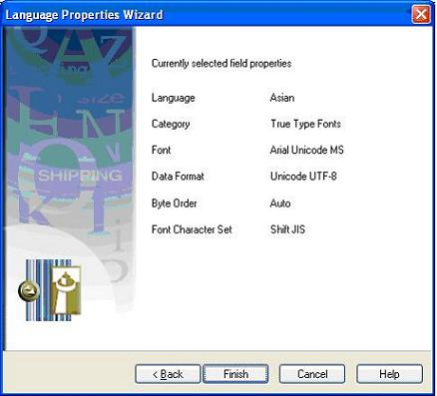Printing Multiple Languages Using Loftware's Language Properties Wizard
Description
This article provides suggestions and key points for printing multinational labels.
Solution
The Loftware Label![]() A label is a design area on the computer screen where a label format is created or edited. Manager User's Guide has a chapter dedicated to international printing. Included in this chapter are detailed instructions for using the Language Properties Wizard.
A label is a design area on the computer screen where a label format is created or edited. Manager User's Guide has a chapter dedicated to international printing. Included in this chapter are detailed instructions for using the Language Properties Wizard.
While no keyboard entry of Unicode or Double byte data is supported, you can connect Loftware to a Unicode database field or pass the data through one of the following:
- .pas file
- .csv file
- .xml file
- Loftware's ActiveX Client Control
 This provides the functionality to connect to the LPS through a socket connection, similar to Loftware's On-Demand Print Client and Status Client. This allows users to get Job Status information, send files faster, and even send files between different networks.
This provides the functionality to connect to the LPS through a socket connection, similar to Loftware's On-Demand Print Client and Status Client. This allows users to get Job Status information, send files faster, and even send files between different networks. - File data source.
Beginning in Loftware version 9.1, Unicode or Double byte data can also be copied directly into fixed fields on the label.
Although Loftware supports international fonts that are native to the various printer families, methods for using these fonts may vary widely based on the family and/or model. In order to meet the widest application, the use of Loftware's Language Properties Wizard and True Type fonts is strongly encouraged.
Issues to consider
- Some True Type fonts support multiple code pages and contain glyphs for multiple languages. The True Type font Arial Unicode MS supports most Microsoft code pages so this font contains glyphs for nearly every language. If you want one variable text field to be able to support different languages, Arial Unicode MS, which is normally distributed with Microsoft Office, would be a very good font choice.
- Within the Language Properties Wizard, UTF-8 is the recommended data format for double byte data. If you are dropping a file to the LPS (.pas, .csv, .xml), make sure the file encoding is set to UTF-8 (matching the Language Properties Wizard settings). To check the file encoding, you can open the .pas, csv., or .xml file with Notepad and click on File | Save As_ and view the Encoding setting. The choices are ANSI
 American National Standards Institute, a non-governmental organization responsible for the coordination of voluntary national (United States) standards., Unicode, Unicode big-endian, or UTF-8.
American National Standards Institute, a non-governmental organization responsible for the coordination of voluntary national (United States) standards., Unicode, Unicode big-endian, or UTF-8. - byte fonts typically will not support Asian characters. When in doubt, select Asian (Double Byte/Unicode) when the Language Properties Wizard prompts "What language do you wish to print?"Here's a screenshot of some typical settings for a field that has been modified using the Language Properties Wizard.
Following are the responses to the Language Properties Wizard:
- When prompted by the Language Properties Wizard to select a language (Non-Asian or Asian), Asian (Double Byte/Unicode) was selected as this field may contain double byte characters.
- If your selected printer natively supports Unicode or double byte data, you will be prompted to select a Font Category (True Type or Native). True Type is the suggested response.
- The next prompt is to select a character set. Shift JIS
 Common Japanese character set consisting of around 7000 characters, which also includes a single byte set and is able to interpret ASCII hex codes correctly was selected, however, in this case any character set could have been selected. Why? Because your choice of character set will be followed by a list of True Type fonts that support the selected character set. Since the True Type font Arial Unicode MS is installed on this system, it will be listed as a choice for any character set selected.
Common Japanese character set consisting of around 7000 characters, which also includes a single byte set and is able to interpret ASCII hex codes correctly was selected, however, in this case any character set could have been selected. Why? Because your choice of character set will be followed by a list of True Type fonts that support the selected character set. Since the True Type font Arial Unicode MS is installed on this system, it will be listed as a choice for any character set selected. -
Next are the True Type Font selections: For the True Type Font, Arial Unicode MS was selected. Again_this font will print just about any character for any language! For the Data Format, Unicode UTF-8 is a pretty standard format. If you're not sure which format to use, use UTF-8.
Article Number
2009236
Versions
8.x Or Newer
Environment
All supported installation environments.

